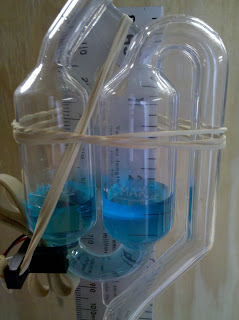I found another pressure sensor made by Honeywell (HSCSAAN001PDAA5) that has significantly higher accuracy, but it is also MUCH more expensive ($40-50 per sensor). So I'm going to try some other specific gravity measurement ideas before I invest money in the pricey new pressure sensor.
Lately I've been experimenting with counting CO2 bubbles produced by a fermentation as an indirect way of measuring specific gravity. Currently I'm using a method which shines an infrared beam through an air lock. When a certain amount of CO2 has been produced in the reaction chamber a CO2 bubble goes through the liquid contained in the air lock (which really just acts as a one-way valve). When this bubble escapes it breaks the infrared beam momentarily which I can then detect electronically.
So far I've proven that I can detect bubbles with this apparatus; now I need to make sure that I can detect close to 100% of the escaping bubbles. Here are some pictures of my current test setup:

